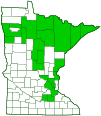northern amber bumble bee
(Bombus borealis)
Conservation • Description • Habitat • Ecology • Distribution • Taxonomy
|
|
||||||||||||||
Description |
Northern amber bumble bee is a large, frequently found, colonial, ground-nesting bumble bee. The female (worker) bee is ½″ long. The thorax and abdomen are densely covered with short hairs. The thorax is bright yellow with a conspicuous black stripe between the bases of the wings and some darker, brownish-gray hairs on the sides. There are six abdominal segments. The first through fourth are yellow, the fifth and sixth are black. The head is mostly black. There are two large compound eyes, one on each side of the head; and three small simple eyes (ocelli) in a triangular pattern at the top of the head between the compound eyes. The middle ocellus is larger than the the two lateral ones. The top of the small (lateral) ocelli are on a virtual line (supraorbital line) with the top of the compound eyes. There are pale hairs around the base of the antennae and conspicuous bright yellow hairs on the top of the head and on the face. The hairs above the ocelli are usually entirely yellow. The tongue is short. The antennae have 12 segments. The fifth antenna segment is longer than the third or fourth. The wings are lightly brownish tinged with dull brick red to black veins. The queen is similar but larger. The male (drone) is similar but smaller and has longer hairs, 7 abdominal segments, and 13 antennae segments. The hairs at the base of the antennae are mostly black. Abdominal segments 5 and 6 are black at the base with considerable yellow hairs at the apex. Segment 7 is black with long black hairs. |
Size |
Queen: 11 ⁄16″ to ⅞″ Male: 9 ⁄16″ to ⅝″ Worker: ½″ |
Similar Species |
Golden northern bumble bee (Bombus fervidus) has black hairs on the top of the head and on the face. The hairs above the ocelli may have some short yellow hairs mixed with the longer black hairs. The sides of the thorax are covered with yellow hair. |
Habitat |
Woodlands |
Ecology |
Season |
May to September |
Behavior |
Bumble bees will sting to protect themselves or their nest. The stinger is not barbed and the bee can sting multiple times. |
Life Cycle |
Overwintering queens emerge from hibernation in May. After emerging, a queen will forage for pollen, and search for a new site. When one is found she will construct a hollow consisting of an egg chamber and a honeypot. She tends to her brood by sitting on them, fanning them with her wings, and feeding them. When adults emerge they feed themselves from the honeypot and take over care of the brood. Nests do not survive the winter. Males die soon after mating. Old queens and workers are killed by cold weather in the fall, while new mated queens hibernate beneath the soil litter. |
Larva Food |
Larvae are fed both nectar for carbohydrates and pollen for protein. |
Adult Food |
Adults feed mostly on nectar but also on some pollen. |
Distribution |
||
|
Sources |
|
| 7/8/2024 | ||
Occurrence |
||
Frequently found |
||
Taxonomy |
|
Order |
Hymenoptera (Ants, Bees, Wasps, and Sawflies) |
Suborder |
Apocrita (Narrow-waisted Wasps, Ants, and Bees) |
Infraorder |
Aculeata (Ants, Bees, and Stinging Wasps) |
Superfamily |
Apoidea (Bees and Apoid Wasps) |
Epifamily |
|
Family |
Apidae (honey bees, bumble bees, and allies) |
Subfamily |
Apinae (honey, bumble, longhorn, orchid, and digger bees) |
Tribe |
Bombini (bumble bees) |
Genus |
|
Subgenus |
Subterraneobombus |
In the not-too-distant past, bumble bees were often placed in the in the subfamily Bombinae, and sometimes in the family Bombidae. Today, both of these terms are considered taxonomically invalid, though they can still be found in use on the Web. |
|
Subordinate Taxa |
|
|
|
Synonyms |
|
|
|
Common Names |
|
boreal bumble bee northern amber bumble bee |
|
Glossary
Ocellus
Simple eye; an eye with a single lens. Plural: ocelli.
Minnesota Bumble Bee Identification Guide
The University of MN Bee Lab has a free field identification guide to Minnesota bumble bees. It is indispensable for amateur naturalists or anyone wanting to identify the bumble bee in their photo. Click on the image below to download the guide.
Visitor Photos |
||
Share your photo of this insect. |
||
This button not working for you? |
||
Dan W. Andree |
||
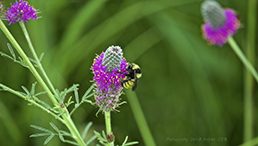 |
||
Bumble Bee on Purple Prairie Clover.... Taken at Sandpiper Prairie SNA rural Norman Co. Mn. July 20 2018. |
Funny little Bumble Bee... Coming in for a landing on one of the flowering thistle at Frenchman’s Bluff SNA July 2024. This is a closer image of thistle out of the same group of thistle in the previous image sent of the several standing straight and fairly tall group. Funny little bumble bee. |
|
Bill Reynolds |
||
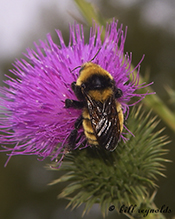 |
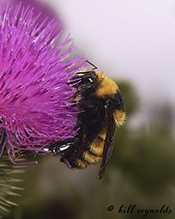 |
|
There is a pretty good sized Bull Thistle patch near where I live that the bees and butterflies are working pretty hard. |
||
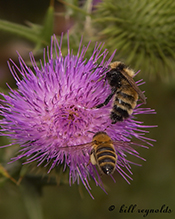 |
||
MinnesotaSeasons.com Photos |
||
|
||
|
||

Visitor Videos |
||
Share your video of this insect. |
||
This button not working for you? |
||
|
Other Videos |
||
B. borealis |
About
Published on Sep 11, 2015 The Northern Amber Bumble Bee |
Male B. borealis gets scared of passing cars, but not too scared. |
About
Published on Aug 9, 2017 Male Bombus borealis, boreal bumble bee, rests. |
Male B. borealis showing its parts. |
About
Published on Mar 17, 2018 bumble bee, bumblebee, Bombus, |

Visitor Sightings |
||
Report a sighting of this insect. |
||
This button not working for you? |
||
| Dan W. Andree 7/20/2018 |
Location: Sandpiper Prairie SNA rural Norman Co. Mn. |
 |
| Bill Reynolds 9/9/2015 |
Location: Pennington Co. |
 |
| Bill Reynolds 9/5/2015 |
Location: Pennington Co. There is a pretty good sized Bull Thistle patch near where I live that the bees and butterflies are working pretty hard. |
 |
MinnesotaSeasons.com Sightings |
||
|

Created: 9/6/2015 Last Updated: © MinnesotaSeasons.com. All rights reserved. |
